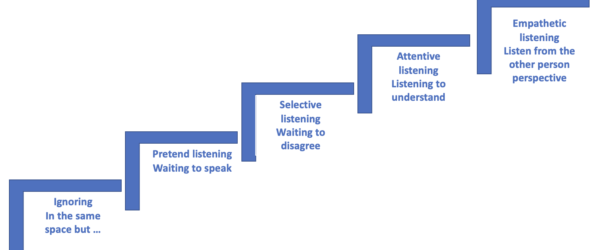4 tips for leaders to increase inclusion for higher performance
Let’s start trying to:
Championing listening and questions in meetings
Focus our effort on building bridges and visions across functions
Ask for “reverse” feedback to create a “partnership culture”
Be aware of our own believes and our own unconscious biais
“Dream big. Start small. Bust most of all start.” (Simon Sinek)
1. Championing listening and questions in meetings
Who has never been in a meeting, where just a few people express their views, where subordinates let their boss talk while others are doing other tasks?
On the contrary, we might experience tremendous progress where bringing inputs together we come to a great solution, reaching “flow” state where we are all so productive.
How?
As a senior leader: encourage others to talk since naturally people tend to stay politely silent in front a more senior person
As a meeting coordinator: start using collaborative white board, make sure time is well balanced between people avoiding monolog from some people or silence from others
But most importantly, for all and (even more as a leader)
- Target active presence and listening and ask powerful questions
- Not try to multitask !! indeed human beings are mono task (women too!)
If you still believe you are an exception, look at this article from John Medina, molecular biologist, author of the best seller book “Brainrules”.
So unfortunately multi-tasking is a myth and highly unproductive for yourself and people in meeting who count on your contribution …
So, next meeting, what about trying to reach the next level of listening?
2. Focus your effort on building bridges and visions across functions
All companies tend to create silos with their departments using their own jargon, their expertise standards. But in reality, we all pursue same company goals and we are all complementary.
For instance: project management and product management. They are their respective framework (PMI or Prince 2 , SAFe or scrum), with their own jargon.
In practice we need both: project management focuses on delivering a project on time, budget, quality, while product management focused on building reusable features and full product cycle.
Some ideas to build bridges:
- Share & Learn sessions across functions, involving stakeholders, reconciliate “jargons”
- Engage stakeholders at building a mid-term vision beyond immediate stakes and aligned with company goals
- COMMUNICATE: in simple terms, ask professional colleagues to help you

3. Ask for “reverse” feedback to create a “partnership culture” beyond organisation in place
It is a given that feedback to an employee is important to grow and for performance.
This is true at team level as well: “Lesson learnt” on projects, “retrospective” in scrum. Many companies put in place employees engagement survey, or some 360 feedback analysis, which is a great progress as well.
However, it is not yet very common to have leaders asking for individual feedback to their team members or across various levels, or even to their suppliers, being really open for a change.
“What do you think about how we are working together”
“How can we better support you to lead efficient decision coordination or your next committee?”
“How can our team meeting be more useful?”
“As a client, what can we do better to help you to help us more?”
The very simple framework: Continue/Stop/Start can be very helpful.
This can be a real cultural shift to make a company grow. Indeed this increases trust and breaks the “top down” approach which does not help for creativity, “re”powerment*, or simply emergence of different kind of leadership.
* Turn the Ship Around, L. David Marquet : “empowerment still results from and is a manifestation of a top-down structure. At its core is the belief that the leader “empowers” the followers, that the leader has the power and ability to empower the followers.”
This idea is very much linked to Drive from Daniel Pink which describes the incredible power of intrinsic motivation to perform at ones’s best.
4. Be aware of our believes and our unconscious biais
A common believe of leaders is that we must be perfect in front of our teams, no showing feelings and show only perfect things, putting a huge pressure on themselves and to others.
At times where talents full inclusion, agility, innovation are crucial for the future, what if leaders would try to inspire their teams by the WHY and the HOW rather the WHAT?
For instance: the way they are learning, the way they are solving a difficult situation, the way they are able to recognise their weaknesses, their mistakes and actively work on them?
This trend of showing vulnerability is becoming more recognized as powerful and unlocks a real potential opportunity where people can be truly themselves and grow together.
Related to unconscious biais, we all have some. According to studies, most common ones still persisting are Age and Gender.
So who are you going to bring for the next event or client meeting?
Next time you make a recommendation on LinkedIn or an assessment of performance, review your first draft having this biais in mind!

Research report from Murray Edwards college outlines that we tend to use different words on performance for men/women or we tend to bring more men to external event (client meeting, forum) despite they are great opportunities to develop further inclusion and all its benefits.

